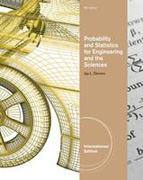
This market-leading text provides a comprehensive introduction to probabilityand statistics for engineering students in all specialties. Proven, accurate,and lauded for its excellent examples, "Probability and Statistics for Engineering and Science, 8th edition, International Edition" evidences Jay Devore's reputation as an outstanding author and leader in the academic community. Devore emphasizes concepts, models, methodology, and applications as opposed to rigorous mathematical development and derivations. Aided by his lively and realistic examples, students go beyond simply learning about statistics - they alsolearn how to put statistical methods to use. INDICE: 1. OVERVIEW AND DESCRIPTIVE STATISTICS. Populations, Samples, and Processes. Pictorial and Tabular Methods in Descriptive Statistics. Measures of Location. Measures of Variability. Supplementary Exercises . 2. PROBABILITY.Sample Spaces and Events. Axioms, Interpretations, and Properties of Probability. Counting Techniques. Conditional Probability. Independence. SupplementaryExercises. 3. DISCRETE RANDOM VARIABLES AND PROBABILITY. Random Variables. Probability Distributions for Discrete Random Variables. Expected Values. The Binomial Probability Distribution. Hypergeometric and Negative Binomial Distributions. The Poisson Probability Distribution. Supplementary Exercises. 4. CONTINUOUS RANDOM VARIABLES AND PROBABILITY DISTRIBUTIONS. Probability Density Functions. Cumulative Distribution Functions and Expected Values. The Normal Distribution. The Exponential and Gamma Distributions. Other Continuous Distributions. Probability Plots. Supplementary Exercises. 5. JOINT PROBABILITY DISTRIBUTIONS AND RANDOM SAMPLES. Jointly Distributed Random Variables. Expected Values, Covariance, and Correlation. Statistics and Their Distributions. The Distribution of the Sample Mean. The Distribution of a Linear Combination. Supplementary Exercises. 6. POINT ESTIMATION. Some General Concepts of Point Estimation.Methods of Point Estimation. Supplementary Exercises. 7. STATISTICAL INTERVALS BASED ON A SINGLE SAMPLE. Basic Properties of Confidence Intervals. Large-Sample Confidence Intervals for a Population Mean and Proportion. Intervals Based on a Normal Population Distribution. Confidence Intervals for the Variance and Standard Deviation of a Normal Population. Supplementary Exercises. 8. TESTS OF HYPOTHESES BASED ON A SINGLE SAMPLE. Hypotheses and Test Procedures. Tests About a Population Mean. Tests Concerning a Population Proportion. P-Values.Some Comments on Selecting a Test. Supplementary Exercises. 9. INFERENCES BASED ON TWO SAMPLES. z Tests and Confidence Intervals for a Difference Between Two Population Means. The Two-Sample t Test and Confidence Interval. Analysis of Paired Data. Inferences Concerning a Difference Between Population Proportions. Inferences Concerning Two Population Variances. Supplementary Exercises. 10. THE ANALYSIS OF VARIANCE. Single-Factor ANOVA. Multiple Comparisons in ANOVA. More on Single-Factor ANOVA. Supplementary Exercises. 11. MULTIFACTOR ANALYSIS OF VARIANCE. Two-Factor ANOVA with Kij = 1. Two-Factor ANOVA with Kij = 1.Three-Factor ANOVA. 2p Factorial Experiments. Supplementary Exercises. 12. SIMPLE LINEAR REGRESSION AND CORRELATION. The Simple Linear Regression Model. Estimating Model Parameters. Inferences About the Slope Parameter a1. InferencesConcerning Y-x* and the Prediction of Future Y Values. Correlation. Supplementary Exercises. 13. NONLINEAR AND MULTIPLE REGRESSION. Aptness of the Model and Model Checking. Regression with Transformed Variables. Polynomial Regression. Multiple Regression Analysis. Other Issues in Multiple Regression. Supplementary Exercises. 14. GOODNESS-OF-FIT TESTS AND CATEGORICAL DATA ANALYSIS. Goodness-of-Fit Tests When Category Probabilities Are Completely Specified. Goodness-of-Fit Tests for Composite Hypotheses. Two-Way Contingency Tables. Supplementary Exercises. 15. DISTRIBUTION-FREE PROCEDURES. The Wilcoxon Signed-Rank Test. The Wilcoxon Rank-Sum Test. Distribution-Free Confidence Intervals. Distribution-Free ANOVA. Supplementary Exercises. 16. QUALITY CONTROL METHODS. General Comments on Control Charts. Control Charts for Process Location. Control Charts for Process Variation. Control Charts for Attributes. CUSUM Procedures. Acceptance Sampling. Supplementary Exercises.
- ISBN: 978-0-8400-6827-8
- Editorial: Cengage Learning
- Encuadernacion: Rústica
- Páginas: 736
- Fecha Publicación: 18/03/2011
- Nº Volúmenes: 1
- Idioma: Inglés
